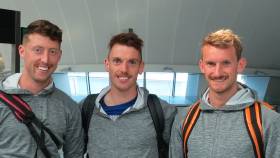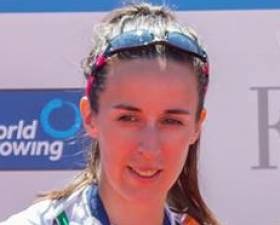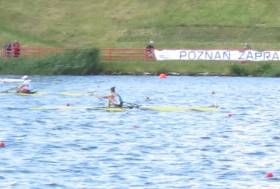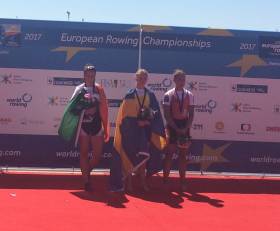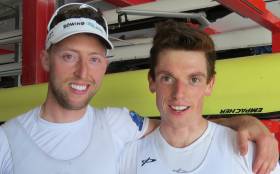Displaying items by tag: O'Donovan
Ireland's Golden Boys Set To Return after World Rowing Championships
#Rowing: The Ireland gold medallists Mark O’Donovan and Shane O’Driscoll and Paul O’Donovan are due to arrive back in Ireland tomorrow (Sunday). They are due in Dublin Airport at about 10 o’clock. They will travel to Skibbereen for a special event in the evening.
Gary O’Donovan, who took a silver medal at the Olympic Games but missed the World Rowing Championships in Florida through illness, will also be flying in.
Brilliant Gold Medal for O'Driscoll and O'Donovan at World Rowing
#Rowing: Ireland’s lightweight pair of Mark O’Donovan and Shane O’Driscoll took a brilliant gold medal at the World Rowing Championships in Sarasota-Bradenton in Florida. They got a tough challenge from Italy and Brazil, but O’Donovan and O’Driscoll produced a stunning row, with a stroke rate of well into the 40s right through the race. They took over the lead at 750 metres and never gave it up, despite concerted challenges by, first, Brazil and then Italy, who took second, with the South Americans taking bronze.
RTÉ to Cover Ireland at World Rowing Championships
#Rowing: Teams from 69 nations have travelled to Sarasota-Bradenton in Florida, USA to compete in the 2017 World Rowing Championships. Over 900 athletes will be competing. Unfortunately, one of Ireland’s top medal hopes – the men’s lightweight double sculls crew of Gary and Paul O’Donovan – will not feature as Gary has been forced to withdraw due to illness. Instead, Paul O'Donovan will compete in the lightweight men's single sculls in a bid to retain his title of World Champion.
Mark O’Donovan and Shane O’Driscoll will compete in the lightweight men’s pair, rounding off an incredible year for the crew. They remain unbeaten in this category across the three World Cup events of 2017, as well as taking the title of European Champions. A newly-formed heavyweight men’s pair of Patrick Boomer (Belfast Rowing Club) and Fionnán McQuillan-Tolan (NUIG) will also compete, The Ireland women’s pair comprises Aileen Crowley (UCD) and Aifric Keogh (UCC). The two remaining women’s crews are double Olympian Sanita Puspure of Old Collegians in the women’s single sculls, and 2017 European silver medallist Denise Walsh from Skibbereen in the women’s lightweight single.
RTÉ have confirmed that there will be live coverage of the event from Thursday 28th September on RTÉ2. Joe Stack will be joined in studio by Neville Maxwell and Sinead Lynch (née Jennings), with commentary from Ger Canning and Sam Lynch. Evanne Ní Chuillin will also be reporting from Sarasota.
Coverage begins at the following times:
- Thursday 28th Sept: 3:00pm
- Friday 29th Sept: 4:30pm
- Saturday 30th Sept: 4:30pm
- Sunday 1st Oct: 3:30pm
- Sunday 1st Oct: 8:00pm (Highlights)
#Rowing: Barry O’Flynn of Cork Boat Club came from behind to win the junior single sculls title at the Irish Rowing Championships in Cork today. Jack Dorney of Shandon tested the favourite in an exciting race – and went ahead. O’Flynn came back and won by a length.
Two of the top junior women were involved in impressive wins. Hannah Scott teamed up with Katie Shirlow to win the intermediate pairs for Bann, while Margaret Cremen and Aoife Lynch won the junior doubles.
NUIG won two sucessive finals, the women’s club coxed four and the men’s intermediate coxed four, while UCC had started the first session of finals at the Championships with a win in the novice coxed quadruple.
Skibbereen called on the class of their international brigade to also win twice: Paul and Gary O’Donovan were untested in their senior doubles win, while Denise Walsh stroked the women’s senior four to a fine win over UCD.
Irish Rowing Championships, National Rowing Centre, Day One (Selected Results)
Men
Four – Inter, coxed: NUIG 6:13.38.
Sculling, Quadruple – Novice, coxed: UCC 6:39.37.
Double – Senior: Skibbereen 7:06.89.
Single – Junior: Cork (B O’Flynn) 7:04.06.
Women
Four – Senior: Skibbereen 6:40.58. Club, coxed: NUIG 7:10.92.
Pair – Inter: Bann 7:19.32.
Sculling, Double – Junior: Lee 7:09.86.
Stars Come Out for Huge Irish Rowing Championships
#Rowing: A bumper weekend of racing is in store in Cork as the 2017 Irish Rowing Championships take place at the National Rowing Centre from Friday, July 14th to Sunday, July 16th. The event will showcase some of the best rowing Ireland has to offer with 1049 crews competing in 264 races.
The National Rowing Centre will welcome 60 clubs, including Waterville and Flesk Valley, who will compete at the Championships for the first time, as well as a re-formed Newry Rowing Club.
High Performance athletes including Gary and Paul O’Donovan, Sanita Puspure and Claire Lambe will be among those competing for the much coveted “Pots”, as well as European Champions Shane O’Driscoll and Mark O’Donovan, and European Silver medallist Denise Walsh.
Three superb days of racing were enjoyed at last year’s Championships, which came to a spectacular end with the men’s senior eights being fought right to the line. Commercial Rowing Club came away with the “Big Pot” in the end after a thrilling race, which saw them finishing less than a second ahead of rivals UCD.
Skibbereen, in combination with UCC, won the women’s senior eight. That win took Skibbereen’s overall tally for the Championships to 13 – they now have 163 titles in total, 11 clear of nearest rivals, Neptune (152).
Commercial and UCD Double Test O'Donovans at Cork Regatta
#Rowing: Niall Beggan and Andrew Goff gave Gary and Paul O’Donovan a good battle in the Division One double sculls at Cork Regatta today. The Ireland under-23 lightweights, drawn from UCD and Commercial, placed second behind the Ireland senior lightweight double, ahead of Shane O’Driscoll and Mark O’Donovan.
NUIG won the men’s fours and the Skibbereen/UCC composite the women’s four by convincing margins. Cork won the women’s double, while Lee’s juniors took second.
Cork Regatta, National Rowing Centre, Cork, Day Two (Selected Results)
Men
Four – Div One – A Final: 1 NUIG (sen) 6:16.41. Four, coxed – Div Two – A Final: 1 Queen’s B (club two) 6:53.69, 2 St Michael’s (jun 18B) 6:56.53; 6 Presentation, Cork (jun 16) 7:33.61.
Sculling, Double – A Final: 1 Skibbereen (G O’Donovan, P O’Donovan; sen) 6:25.51, 2 Commercial, UCD (N Beggan, A Goff; sen) 6:27.62, 3 Skibbereen (M O’Donovan, S O’Driscoll; sen) 6:37.997; 5 Three Castles A (jun 18A) 6:49.76. B Final: St Michael’s (inter) 6:51.20.
Single – Div Two – A Final: 1 Three Castles (A Keogh; jun 16) 7:29.64, 2 Cappoquin (S Landers; club two) 7:35.39; 6 Killorglin (J McCarthy; Jun 18B) 7:52.86.
Women
Four – Div One – A Final: 1 Skibbereen, UCC (N Casey, E Hegarty, A Keogh, D Walsh; sen) 6:59.0. B Final: Col Iognaid (jun 18A) 7:39.68.
Sculling, Double – Div One – A Final: 1 Cork (inter) 7:19.591, 2 Lee (jun 18A) 7:23.45. B Final: 2 Carlow (club one) 7:40.31.
Dukarska Chosen in Ireland Team for Final World Cup
#Rowing: Monika Dukarska has been chosen to represent Ireland at the third World Cup Regatta in Lucerne early next month. The Killorglin woman finished ninth (third in the B Final) on her first foray as a single sculler at a World Cup event, in Poznan in Poland last weekend. She joins Sanita Puspure, who won the B Final in Poland. The Ireland lightweight pair of Shane O’Driscoll and Mark O’Donovan, who have taken gold in the previous two World Cups and in the European Championships will hope to continue their run. The lightweight double of Paul and Gary O’Donovan were silver medallists at the Europeans and in the World Cup in Poznan.
#Rowing: Ireland made a brilliant start to the final day of the European Rowing Championships.
Mark O’Donovan and Shane O’Driscoll dominated the men’s lightweight pair to take gold and, immediately afterwards, Denise Walsh took a gutsy silver medal in the lightweight single sculls.
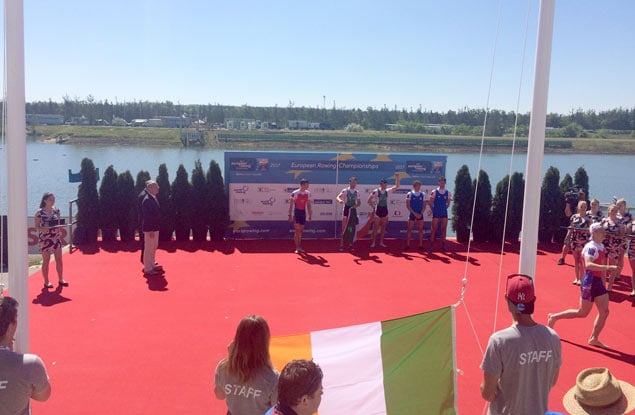 Mark O'Donovan and Shane O'Driscoll medal ceremony
Mark O'Donovan and Shane O'Driscoll medal ceremony
European Rowing Championships, Day Three (Selected Results; Irish interest)
Men
Lightweight Pair – A Final:
1 Ireland (M O’Donovan, S O’Driscoll) 6:32.34, 2 Russia 6:34.74, 3 Italy 6:34.89; 4 Britain (J Cassells, S Scrimgeour) 6:39.75.
Women
Lightweight Single Sculls – A Final: 1 Sweden (E Fred) 7:36.24, 2 Ireland (D Walsh) 7:38.00, 3 Switzerland (P Merz) 7:39.94.
O'Driscoll and O'Donovan Give Classy Display
#Rowing: Mark O’Donovan and Shane O’Driscoll took advantage of the good conditions on the beautiful course to win their exhibition race in the men’s lightweight pair at the European Rowing Championships in Racice. The race counts in the allocation of lanes in the final, and Britain, represented by Joel Cassells and Sam Scrimgeour, and Ireland shot it out the last time this happened, at the World Cup in Belgrade. However, this time Ireland were in command from halfway, tested only by Italy, who finished second.
European Championships, Racice, Czech Republic, Day One (Selected Results; Irish interest)
Men
Lightweight Pair – Exhibition (Race for Lanes): 1 Ireland (M O’Donovan, S O’Driscoll) 6:57.77, 2 Italy 6:59.82, 3 Russia 7:01.75, 4 Britain (J Cassells, S Scrimgeour) 7:03.39.
Lightweight Double Sculls – Heats (Winner to A/B Semi-Finals; rest to Repechages) – Heat One: 1 France (P Houin, J Azou) 6:26.97. Heat Two: Germany (L Schaefer, J Osborne) 6:37.53.
Heat Three: 1 Poland 6:25.93, 2 Ireland (G O’Donovan, P O’Donovan) 6:32.15, 3 Russia 6:36.38, 4 Switzerland 6:40.60, 5 Austria. Heat Four: 1 Italy 6:30.77.
Women
Lightweight Single Sculls – Heat One (First Three to Semi-Finals; rest to Repechage): 1 Ireland (D Walsh) 7:44.85, 2 Denmark (A Runge Holmegaard) 7:49.49, 3 Poland (J Dorociak) 7:49.90; 4 Czech Republic 8:05.07, 5 Portugal 8:08.19. Heat Two: 1 Switzerland 7:42.510. Heat Three: 1 Sweden 7:39.52.
Gold for O'Driscoll and O'Donovan at World Cup
#Rowing: Ireland won the first gold medal of the World Cup Regatta in Belgrade this morning through an outstanding performance by Mark O’Donovan and Shane O’Driscoll in the lightweight pair. They took on and beat the Britain crew of Joel Cassells and Sam Scrimgeour – who in a tight finish could not hold second and finished third behind Russia.
O'Donovan told the official worldrowing site that they felt good during the race and gave credit to Dominic Casey, who is now the Ireland head coach. "Going forward we are going to a training camp in Varese and looking to implement new training and technique before Europeans.”
Cassells said: “We knew it was going to be a challenge. It was a pretty hard finish. The plan is to learn, the future is to get to the European Championships and retain the title.”
World Cup Regatta, Belgrade (Selected results; Irish interest)
Men
Lightweight Pair – Final: 1 Ireland (M O’Donovan, S O’Driscoll) 6:46.65, 2 Russia 6:47.67, 3 Britain (J Cassells, S Scrimgeour) 6:48.40.



























